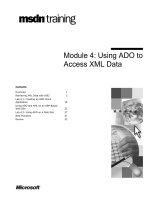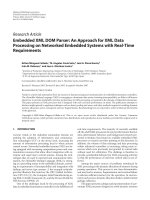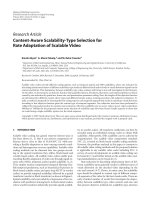Structured content aware discovery for improving XML data consistency
Bạn đang xem bản rút gọn của tài liệu. Xem và tải ngay bản đầy đủ của tài liệu tại đây (993.12 KB, 172 trang )
STRUCTURED CONTENT-AWARE
DISCOVERY FOR IMPROVING XML DATA
CONSISTENCY
Submitted by
THI HONG LOAN VO
A thesis submitted in total fulfillment
of the requirements for the degree of
Doctor of Philosophy
School of Engineering and Mathematical Sciences
Faculty of Science, Technology and Engineering
La Trobe University
Bundoora, Victoria 3086
Australia
October 2013
CONTENT
Contents
List of tables.............................................................................................v
List of figures .........................................................................................vii
Lists .........................................................................................................ix
Acknowledgements .................................................................................xi
Abstract .................................................................................................xiii
Statement of authorship .........................................................................xv
External refereed publications ............................................................xvii
1 Introduction ..........................................................................................1
1.1 Motivation ....................................................................................1
1.1.1 Data consistency .....................................................................3
1.1.2 Requirements of constraint specification ...............................4
1.1.3 Requirements of constraint discovery ...................................5
1.1.4 Consistent data management .................................................6
1.2 Problem definition ......................................................................7
1.3 Overview of our approaches ........................................................9
1.4 Contributions .............................................................................12
1.5 Thesis organization ....................................................................12
2 Related work ......................................................................................15
2.1 XML database ............................................................................15
2.1.1 Document type definition ....................................................16
i
CONTENT
2.1.2 XML data .............................................................................17
2.2 Conditional functional dependency ...........................................19
2.3 Association rule .........................................................................21
2.4 XML Functional dependency .....................................................22
2.4.1 Tree-tuple based functional dependency ..............................23
2.4.2 Path-based functional dependency .......................................24
2.4.3 Extended proposals for XML functional dependency..........25
2.5 Managing data consistency in inconsistent data sources ...........30
2.6 Summary ....................................................................................33
3 Content-based discovery for improving XML data consistency ........37
3.1 Introduction ...............................................................................38
3.2 Preliminaries...............................................................................41
3.3 XML conditional functional dependency ..................................46
3.4 XDiscover:
XML conditional functional dependency discovery ...................49
3.4.1 Search lattice generation.......................................................50
3.4.2 Candidate identification........................................................51
3.4.3 Validation..............................................................................52
3.4.4 Pruning rules .........................................................................54
3.4.5 XDiscover algorithm ............................................................58
3.5 Experimental analysis.................................................................63
3.5.1 Synthetic data........................................................................63
3.5.2 Real life data ........................................................................65
3.6 Case studies ..............................................................................66
3.7 Summary.....................................................................................71
4 A structured content-aware approach
ii
CONTENT
for improving XML data consistency...............................................73
4.1 Introduction ................................................................................73
4.2 Preliminaries ..............................................................................76
4.2.1 Constraints ............................................................................76
4.2.2 XML data tree ......................................................................79
4.3 Structure similarity measurement ..............................................81
4.3.1 Sub-tree similarity ................................................................81
4.3.2 Path similarity.......................................................................84
4.4 XML conditional structural functional dependency...................88
4.5 SCAD: structured content-aware discovery approach
to discover XCSDs .....................................................................91
4.5.1 Data summarization: resolving structural inconsistencies....92
4.5.2 XCSD discovery: resolving semantic inconsistencies..........94
4.5.3 SCAD algorithm ...................................................................96
4.6 Complexity analysis .................................................................100
4.7 Experimental analysis...............................................................101
4.8 Case studies ..............................................................................107
4.9 Summary...................................................................................114
5 Structured content-based query answers
for improving information quality .................................................115
5.1 Introduction .............................................................................116
5.2 Preliminaries ............................................................................118
5.2.1 XPath .................................................................................118
5.2.2 Motivation examples ..........................................................118
5.3 SC2QA: structured content-aware approach
for customized consistent query answers .................................120
iii
CONTENT
5.3.1 Data repair ..........................................................................122
5.3.2 Calculating customized consistent query answers..............128
5.4 Complexity analysis and Correctness.......................................132
5.5 Experimental evaluation ..........................................................135
5.6 Summary .................................................................................138
6 Conclusions ......................................................................................139
6.1 Thesis summary .......................................................................139
6.2 Future work ..............................................................................141
Bibliography ........................................................................................143
iv
LIST OF TABLES
List of Tables
3.1 XDiscover vs Yu08 on the number of discovered constraints ........64
3.2 Samples of constraints
discovered by XDiscover vs that of Yu08........................................64
3.3 Analyzing real life datasets ..............................................................66
4.1 Expression forms of XML functional dependencies .......................78
v
LIST OF TABLES
vi
LIST OF FIGURES
List of Figures
1.1 An simplified inconsistent instance of Customer relation .................3
2.1 An example of DTD.........................................................................16
2.2 An example of an XML document ..................................................18
2.3 An example of data tree ...................................................................19
2.4 An instance of the Bookings relation...............................................19
2.5 A tree-tuple illustration ....................................................................24
2.6 A sub-tree represents a generalized-tree-tuple-based FD ................26
2.7 A sub-tree represents a local functional dependency .............................28
3.1 A Flight Bookings schema tree ........................................................38
3.2 A simplified Bookings data tree containing
semantic inconsistencies ..................................................................40
3.3 A set of containment lattice of A, B and C ......................................51
3.4 A simplified Bookings data tree:
each Booking contains only one Trip................................................53
3.5 A simplified Bookings data tree:
each Booking contains a set of complex element Trip ......................70
4.1 A simplified Bookings data tree
containing structural and semantic inconsistencies..........................76
4.2 An overview of the SCAD approach ...............................................91
4.3 Numbers of candidates checked vs similarity threshold................103
4.4 Time vs similarity threshold ..........................................................103
4.5 SCAD vs Yu08...............................................................................104
4.6 Range of similarity thresholds .......................................................104
vii
LIST OF FIGURES
4.7 A simplified Bookings data tree is constrained by constraints
containing both variable and constants ...........................................111
5.1 An inconsistent Flight Booking data tree
with respect to XCSDs ....................................................................117
5.2 XCSDs on the Flight Bookings data tree .......................................119
5.3 Repairing consistent data ...............................................................126
5.4 Set of XCSDs used in experiments ................................................136
5.5 Set of queries used in experiments.................................................136
5.6 Execution times: constant XCSDs vs variable XCSDs .................137
5.7 Execution times when varying
the number of conditions in queries.....................................................137
viii
LISTS
Lists
3.1 The XDiscover algorithm ................................................................59
3.2 The discoverXCFD algorithm..........................................................60
4.1 The subtree_Similarity algorithm ...................................................83
4.2 The path_Similarity algorithm .........................................................86
4.3 The data_Summarization algorithm ................................................93
4.4 The SCAD algorithm .......................................................................97
4.5 Utility functions of SCAD ...............................................................99
5.1 The SC2QA algorithm ...................................................................129
5.2 Utility functions of SC2QA ...........................................................130
ix
LISTS
x
ACNOWLEDGEMENTS
Acknowledgements
I would especially like to thank the following people.
• First of all, I would like to thank Dr. Jinli Cao for her endless
support. I sincerely appreciate her contribution of time, guidance,
caring help, and advice during the fourth years of my Ph.D. study at
La Trobe University. I also thank her for being very patient with my
progress.
• I wish to express my gratitude to my second co-supervisor,
Professor Wenny Rahayu, for her support and encouragement in
relation to my research in general. She provided very helpful
comments and ideas on my work. She always supported me
whenever I needed her most.
• I owe a very special thank to my good friends, Dr Hong-Quang
Nguyen from International University, Vietnam National University,
Dr Thi Ngoc Nguyen from National University of Singapore and
Dr. Hai Thanh Do for their tremendous support to me. They
provided me with insightful ideas, shared valuable tips on how to
improve my writing skills and how to present technical materials
and gave very helpful comments on my published papers.
• I would like to thank the chair of my research panel Dr Torab Torabi
and Dr Fei Lui for participating in my thesis committee and
xi
ACNOWLEDGEMENTS
providing helpful feedback for every stage of my Ph.D. I also thank
Ms. Michele Mooney for her careful proof reading of my research
papers and the final draft of this thesis.
• I would like to express my gratitude and love to my family for
always being there whenever I needed them most, and for
supporting me throughout all my thesis years. I would like to thank
my parents for their continuous love and support. I would like to
thank my husband Phuc Duat Phan, for his constant love, care and
encouragement.
xii
ABSTRACT
Abstract
With the explosive growth of heterogeneous XML sources, data
inconsistencies have become a serious problem, resulting in ineffective
business
operations
and
poor
decision-making.
XML
Functional
Dependencies (XFDs) are well known as essential semantics to enforce the
data integrity of a source. However, existing approaches to XFDs have
insufficiently addressed data inconsistencies arising from both semantic
and structural inconsistencies inherent in heterogeneous XML data. In this
thesis, we address such prevalent inconsistencies by proposing XDiscover,
SCAD and SC2QA approaches.
XDiscover is a content-based discovery approach which explores
the semantics hidden in data to discover a set of minimal XML conditional
functional dependencies (XCFDs) from a given source to address semantic
inconsistencies. The XCFD notion is extended from XFDs by incorporating
conditions into XFD specifications. The experimental results on the
synthetic and real datasets and the results from the case studies show that
XDiscover can discover more dependencies and the dependencies found
convey more meaningful semantics, in terms of capturing data
inconsistency, than those of the existing XFDs.
SCAD is a structured and content-aware approach which explores
the semantics of data structures and the semantics hidden in the data values
to discover a set of XML conditional structural functional dependencies
(XCSDs) from a given source to address the inconsistencies caused by both
xiii
ABSTRACT
structural and semantic inconsistencies. XCSDs are path and value-based
constraints, whereby: (i) the paths in XCSD approximately represent
groups of similar paths in sources to express constraints on objects with
diverse structures; while (ii) the values bound to particular elements
express constraints with conditional semantics. We conduct experiments
and case studies on synthetic datasets which contain structural diversity and
constraint variety causing XML data inconsistencies. The experimental
results show that SCAD can discover more dependencies and the
dependencies found can capture data inconsistencies disregarded by XFDs.
SC2QA utilizes XCSDs to compute customized consistent query
answers for queries posted to inconsistent data sources to improve
information quality. The query answer is calculated by qualifying queries
with appropriate information derived from the interaction between the
query and the XCSDs. We conduct experiments on synthetic datasets to
evaluate the effectiveness of SC2QA.
xiv
STATEMENT OF AUTHORSHIP
Statement of Authorship
Except where reference is made in the text of this thesis, this thesis
contains no material published elsewhere or extracted in whole or in part
from a thesis submitted for the award of any other degree or diploma.
No other person's work has been used without due acknowledgment in the
main text of the thesis.
This thesis has not been submitted for the award of any degree or diploma
in any other tertiary institution.
Thi Hong Loan Vo
Date: 14/10/2013
xv
STATEMENT OF AUTHORSHIP
xvi
EXTERNAL REFEREED PUBLICATIONS
External Refereed Publications
The results of this thesis have been published in or under reviewed by the
following journals and proceedings:
Vo, L.T.H., Cao, J., Rahayu, W. and Nguyen, H.-Q. Structured contentaware discovery for improving XML data consistency. Information
Sciences, 248(1): 168-190, 2013.
Vo, L.T.H., Cao, J. and Rahayu, W. Discovering Conditional Functional
Dependencies in XML Data. Australasian Database Conference, 143-152,
2011.
Vo, L.T.H., Cao, J. and Rahayu, W. Structured content-based query answer
for improving information quality. World Wide Web, under accepted, Jan
2014.
xvii
EXTERNAL REFEREED PUBLICATIONS
xviii
1. INTRODUCTION
Chapter 1
Introduction
The main theme of this thesis is to study XML data consistency. This
chapter consists of five sections. Section 1.1 highlights the need to
introduce new types of constraints and proposes approaches to discover
anomalies in XML data. Requirements to address data inconsistency are
also discussed in this section as the motivation for this work. Section 1.2
presents the definitions of the problems which are resolved in this thesis.
Section 1.3 briefly introduces our approaches to resolve the identified
problems. Section 1.4 summarizes the main contributions of the thesis. The
thesis organization is outlined in section 1.5.
1.1 Motivation
Extensible Markup Language (XML) has emerged as the standard data
format for storing business information in organizations [6]. Data in these
environments are rapidly changing and highly heterogeneous. This has
increasingly led to the critical problem of data inconsistency in XML data
because the semantics underlying business information, such as business
rules, are enforced insufficiently [58]. XML itself only support for creating
1
1. INTRODUCTION
markup languages used as metadata, it does not guarantee how the
underlying business information must be structured and expressed in
business processes. Data inconsistency appears as violations of constraints
defined over a dataset [43, 80] which, in turn, leads to inaccurate data
interpretation and analysis [47, 68]. Such problems significantly affect the
ability of the system to provide correct information causing inefficient
business operations and poor decision making. XML functional
dependencies (XFDs) [6, 42, 52, 82, 83] have been proposed to increase the
data integrity of the sources. Unfortunately, existing approaches to XFDs
are insufficient to completely address the data inconsistency problem to
ensure that the data is consistent within each XML source or across
multiple XML sources for three main reasons. First, XFDs are defined to
represent constraints globally enforced to the entire document [6, 82],
whereas XML data are often obtained by integrating data from different
sources constrained by local data rules. Thus, they are unable, in some
cases, to capture conditional semantics locally expressed in some fragments
within an XML document.
Second, the existing XFD notions are incapable of validating data
consistencies in sources with diverse structures. This is because checking
for data consistency against an XFD requires objects to have perfectly
identical structures [82], whereas XML data is organized hierarchically
allowing a certain degree of freedom in the structural definition. Two
structures describing the same object may not be identical [75, 94, 95]. In
such cases, using XFD specifications cannot validate data consistency.
Third, existing approaches to XFD discovery focus on structural validation
rather than semantic validation [11, 42, 82, 91]. Most existing work on
constraint discovery only extracts constraints to solely address data
redundancy and normalization [81, 102]. Such approaches cannot identify
anomalies to discover a proper set of semantic constraints to support data
2
1. INTRODUCTION
inconsistency detection. To the best of our knowledge, there is currently no
existing approach which fully addresses the problems of data inconsistency
in XML data. Such limitations in prior work are addressed in this thesis.
In the next section, we present certain technical terms relating to data
consistency which are necessary to understand the remainder of the thesis.
1.1.1 Data consistency
Consistency is a data quality dimension capturing the violation of semantic
rules defined over a dataset. Integrity constraints are instantiations of such
semantic rules which are dependencies typically defined to ensure schema
quality [15]. They are properties which must be satisfied by all instances of
a database. Data inconsistency describes a source which does not respect
one or more constraints defined over a dataset. For example, a condition
could be that, in every
instance, the customer
CId
CName
name
(CName)
C01
Mary
functionally depends on
C01
Bob
C02
Clayton
the customer ID (CId),
i.e., a customer ID is
assigned to, at most, one
customer
name.
Fig 1.1 An simplified inconsistent instance
of Customer relation
This
integrity constraint is a functional dependency (FD) denoted as CId →
CName, indicating that this dependency should hold for the attributes of
the Customer relation. The data in Fig 1.1 is inconsistent with respect to the
above FD. This is because the customer ID of "C01" is assigned to two
different customer names which violates the above functional dependency.
In XML data, the satisfaction of a source to a set of integrity
constraints often cannot be guaranteed, hence, data inconsistency occurs
3
1. INTRODUCTION
[43, 80]. Data inconsistency is often caused by semantic inconsistency and
structural inconsistency. Semantic inconsistencies occur when business
rules on the same data vary across different fragments [79]. Structural
inconsistencies arise when the same real world concept is expressed in
different ways, with different choices of elements and structures, that is, the
same data is organized differently [75, 95]. In this work, we define integrity
constraints for instances calling them constraints. Such constraints are
defined based on either the actual data content or data structures to enhance
the data consistency within an XML data source. By data consistency, we
mean that the source syntactically and semantically satisfies a set of
constraints.
In the next section, we discuss the essential features about which
constraints are required to have so that they can prevent data
inconsistencies in XML.
1.1.2 Requirements of constraint specifications
Constraints are essential parts of data semantics used to define the criteria
that a data source should satisfy. Commonly, the validation of XML data
often focuses on the schema level with respect to predefined constraints
expressed in the form of schema [5, 6, 11, 82]. However, XML data are
often integrated from different data sources, and while there are certain
features shared by all data, each fragment might need to maintain certain
constraints differently to suit its unique requirements [91]. The existence of
various constraints holding on the same object across different fragments
causes inconsistencies at the semantic level. In such cases, an additional
validation from the content view with respect to different constraints
holding conditionally on the data is necessary to maintain data consistency.
4
1. INTRODUCTION
By holding conditionally, we mean that each constraint holds on a subset of
the data specified by an accompanying condition.
In addition to semantic inconsistencies, structural inconsistencies
also pose additional challenges to enhance the data consistency. Structural
inconsistencies are often caused by the existing various data structures
representing the same object. That is, XML data can contain data from
different data sources which might contain either nearly, or exactly the
same information, but they are represented by different structures.
Moreover, even though two objects express similar content, each of them
may contain some extra information. In such cases, constraints on XML
data should be allowed to hold on similar objects. In summary, in order to
ensure the data consistency, constraints not only need to define the datavalue bindings to express conditional semantics, but should also be flexible
enough to describe the similarity of objects. As far as we are concerned,
there is no prior work proposing such constraints to validate data
consistency from both structural and content views. We suggest that such
constraints should be maintained to preserve the data consistency of
applications supported by XML data.
From the requirements of constraint specifications, we now discuss
the requirements that discovery approaches should take into account to
explore a proper set of constraints to address data inconsistency arising
from both semantic and structural inconsistencies in XML data.
1.1.3 Requirements of constraint discovery
As XML data becomes more common and its data structures more
complex, it is desirable to have algorithms to automatically discover
anomalies from XML data sources. Although there is existing work [4,
102] on discovering constraints, there still exist certain limitations and
5









